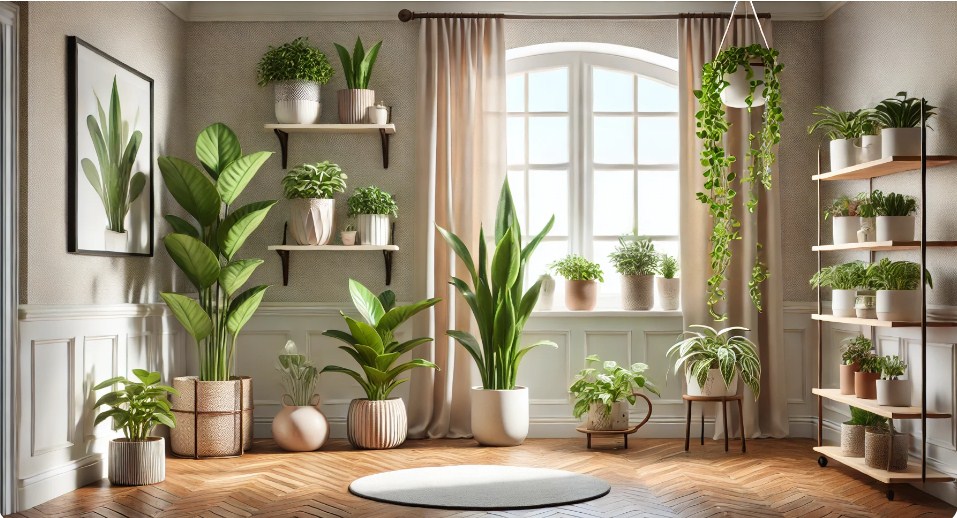Caring for indoor plants has become a major trend—and for good reason. Plants improve air quality, reduce stress, and add a touch of nature to any home. But if you’re just starting out, it’s easy to feel overwhelmed by plant choices, care routines, and conflicting advice.
The good news? Many houseplants are beginner-friendly, requiring minimal effort to thrive. This guide will help you choose the best indoor plants that are nearly impossible to kill and perfect for those who want to grow their green thumb without the pressure.
Why Start with Low-Maintenance Plants?
Low-maintenance indoor plants are forgiving, meaning they can survive occasional neglect or mistakes. They’re perfect for people who:
-
Travel frequently
-
Forget to water sometimes
-
Live in apartments with low light
-
Have never owned a plant before
These plants are a stress-free way to ease into plant parenthood—and gain confidence in your gardening skills.
What Makes a Plant Beginner-Friendly?
When choosing your first indoor plant, look for these traits:
-
Tolerant of low or indirect light
-
Can go days without water
-
Resistant to pests
-
Slow-growing (requires less pruning)
-
Hardy in varying indoor conditions
Let’s take a look at some top contenders that tick all these boxes.
Top 10 Indoor Plants Perfect for Beginners
1. Snake Plant (Sansevieria)
Also known as “Mother-in-Law’s Tongue,” the snake plant is a favorite for its upright, architectural leaves and extreme resilience. It can thrive in both bright and low light and only needs watering every 2–3 weeks.
Bonus: It purifies air by removing toxins like formaldehyde and benzene.
2. Pothos (Epipremnum aureum)
This trailing vine is incredibly adaptable and grows quickly. Pothos thrives in indirect light and even survives in fluorescent-lit rooms. Water it when the top inch of soil feels dry.
Perfect for: Hanging baskets or bookshelves.
3. ZZ Plant (Zamioculcas zamiifolia)
The ZZ plant has shiny, dark green leaves and can tolerate low light, irregular watering, and dry air. It’s one of the most durable indoor plants out there.
Great for: Offices and rooms with minimal natural light.
4. Peace Lily (Spathiphyllum)
Known for its elegant white blooms, the peace lily prefers indirect light and moist soil. It’s also known for removing air pollutants. Water it when the leaves start to droop—a built-in reminder!
5. Spider Plant (Chlorophytum comosum)
This plant produces “baby” plants that dangle from the main foliage, making it easy to propagate. It adapts well to most environments and only needs watering once a week.
Fun fact: It’s pet-friendly!
6. Aloe Vera
Aloe isn’t just useful for treating burns—it’s also an excellent beginner houseplant. It thrives in bright light and dry conditions. Just don’t overwater it.
Best placed near: Sunny windowsills.
7. Chinese Evergreen (Aglaonema)
This plant has striking foliage with splashes of silver, red, or green. It’s ideal for low-light environments and requires watering only when the soil dries out.
8. Jade Plant (Crassula ovata)
A beautiful succulent with thick, glossy leaves. Jade plants prefer bright light and are drought-tolerant. Let the soil dry completely between waterings.
Bonus: With the right care, it can live for decades!
9. Rubber Plant (Ficus elastica)
With its large, glossy leaves, the rubber plant makes a bold statement. It’s fairly easy to care for—just keep it in bright, indirect light and let the soil dry a bit between watering.
10. Lucky Bamboo (Dracaena sanderiana)
Not actually bamboo, but still very easy to grow! Lucky bamboo can live in water (just change it every two weeks) or in soil. It prefers indirect light and is said to bring good fortune.
Where to Place Your Indoor Plants
Even low-maintenance plants need the right conditions. Here are placement tips:
-
North-facing windows: Good for shade-loving plants like peace lilies.
-
East or west windows: Ideal for most beginner plants.
-
South-facing windows: Best for sun-loving species like aloe or jade.
Avoid placing plants directly next to heaters or air conditioners, as temperature extremes can stress them out.
Watering Tips for Beginners
Overwatering is the most common mistake new plant parents make. Here’s how to avoid it:
-
Stick your finger an inch into the soil—if it feels dry, it’s time to water.
-
Use pots with drainage holes to prevent root rot.
-
Empty the saucer under the pot after watering.
-
Err on the side of underwatering rather than overwatering.
Tools and Supplies You Might Need
To get started, you only need a few basic items:
-
Small watering can
-
Pruning scissors
-
Moisture meter (optional but helpful)
-
Clean pots with drainage holes
-
Indoor plant fertilizer (use sparingly)
As you gain experience, you can explore more advanced tools—but start simple.
How to Deal with Common Indoor Plant Issues
Yellow Leaves
Often a sign of overwatering or poor drainage. Check the pot and reduce watering frequency.
Brown Leaf Tips
Usually due to dry air or inconsistent watering. Mist the plant occasionally or use a humidifier.
Pests
Common culprits like spider mites or aphids can be managed with neem oil or insecticidal soap. Always isolate new plants for a few days before placing them near others.
Don’t Be Afraid to Make Mistakes
Plants are living things, and some trial and error is normal. A few brown leaves or dropped stems doesn’t mean you’ve failed—it means you’re learning.
Track your watering days, keep notes, and observe how your plant reacts. You’ll be surprised how quickly you develop an intuitive sense of what each plant needs.
Final Words: Welcome to the Plant Parent Club
Starting with low-maintenance indoor plants is the perfect gateway into the gardening world. With just a little love and attention, your green companions will thrive and bring life to your home. And as your confidence grows, so will your collection.
So go ahead—bring home that snake plant or pothos. It’s the start of something beautiful.
